Logistics Management Analysis and Solutions for Abbott Australia
VerifiedAdded on 2022/10/01
|16
|3265
|21
Report
AI Summary
This report provides an in-depth analysis of logistics management challenges faced by Abbott Australia, a subsidiary of Abbott Laboratories. The report begins with an overview of Abbott's operations, highlighting the manufacturing and distribution of medical devices. It then identifies key issues, including increasing customer demand for better service, inventory turnover problems, and product obsolescence. The analysis delves into relevant theories of logistics management, including inbound and outbound logistics, and the key functions such as order processing, network design, material handling, and inventory management. Finally, the report proposes solutions to address the identified issues, such as using cloud-based software for real-time inventory tracking and optimizing the supply chain to improve product availability and reduce costs. The report aims to provide actionable recommendations to enhance Abbott Australia's logistics management and maintain its competitive edge in the medical device market.
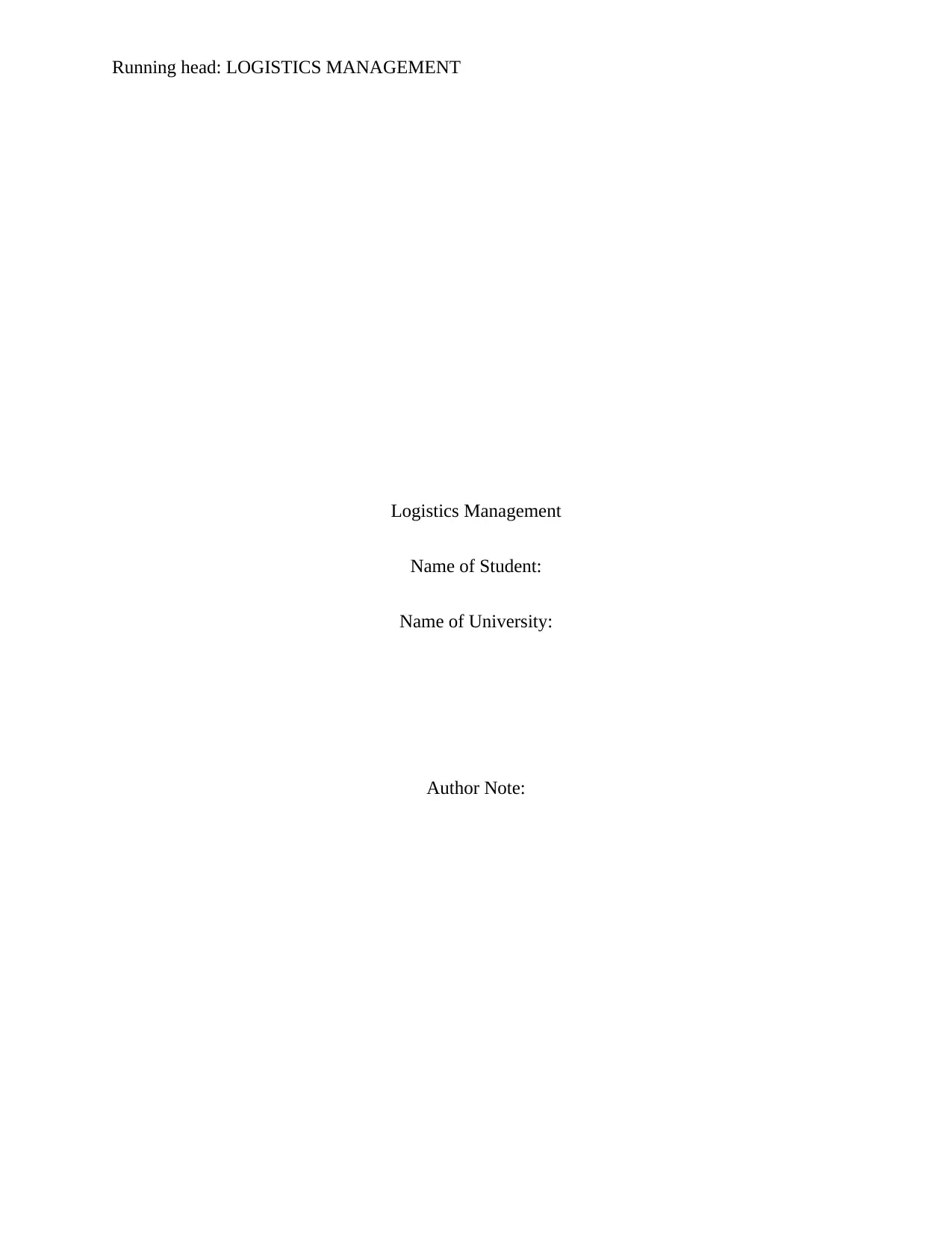
Running head: LOGISTICS MANAGEMENT
Logistics Management
Name of Student:
Name of University:
Author Note:
Logistics Management
Name of Student:
Name of University:
Author Note:
Paraphrase This Document
Need a fresh take? Get an instant paraphrase of this document with our AI Paraphraser
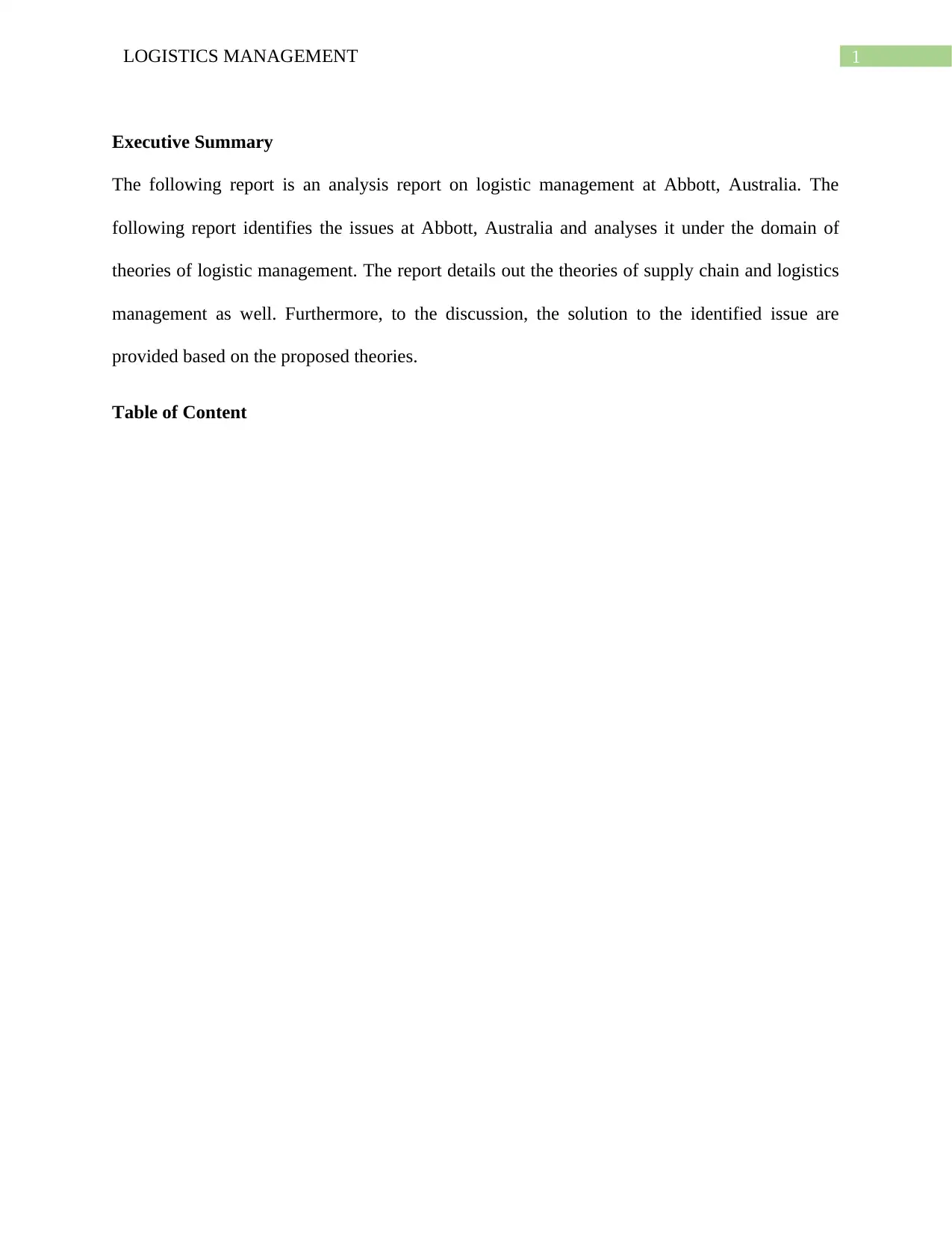
1LOGISTICS MANAGEMENT
Executive Summary
The following report is an analysis report on logistic management at Abbott, Australia. The
following report identifies the issues at Abbott, Australia and analyses it under the domain of
theories of logistic management. The report details out the theories of supply chain and logistics
management as well. Furthermore, to the discussion, the solution to the identified issue are
provided based on the proposed theories.
Table of Content
Executive Summary
The following report is an analysis report on logistic management at Abbott, Australia. The
following report identifies the issues at Abbott, Australia and analyses it under the domain of
theories of logistic management. The report details out the theories of supply chain and logistics
management as well. Furthermore, to the discussion, the solution to the identified issue are
provided based on the proposed theories.
Table of Content
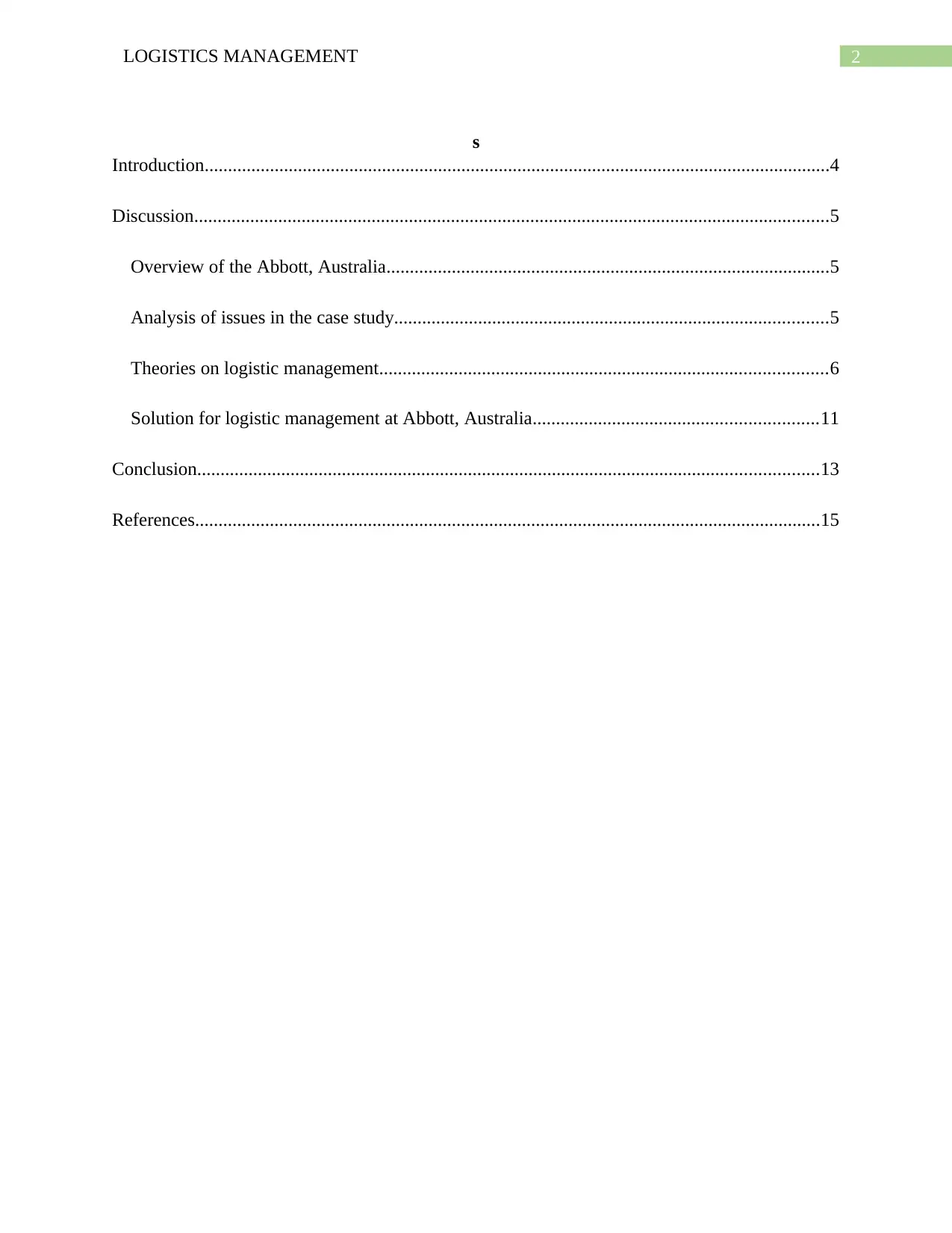
2LOGISTICS MANAGEMENT
s
Introduction......................................................................................................................................4
Discussion........................................................................................................................................5
Overview of the Abbott, Australia...............................................................................................5
Analysis of issues in the case study.............................................................................................5
Theories on logistic management................................................................................................6
Solution for logistic management at Abbott, Australia.............................................................11
Conclusion.....................................................................................................................................13
References......................................................................................................................................15
s
Introduction......................................................................................................................................4
Discussion........................................................................................................................................5
Overview of the Abbott, Australia...............................................................................................5
Analysis of issues in the case study.............................................................................................5
Theories on logistic management................................................................................................6
Solution for logistic management at Abbott, Australia.............................................................11
Conclusion.....................................................................................................................................13
References......................................................................................................................................15
⊘ This is a preview!⊘
Do you want full access?
Subscribe today to unlock all pages.

Trusted by 1+ million students worldwide
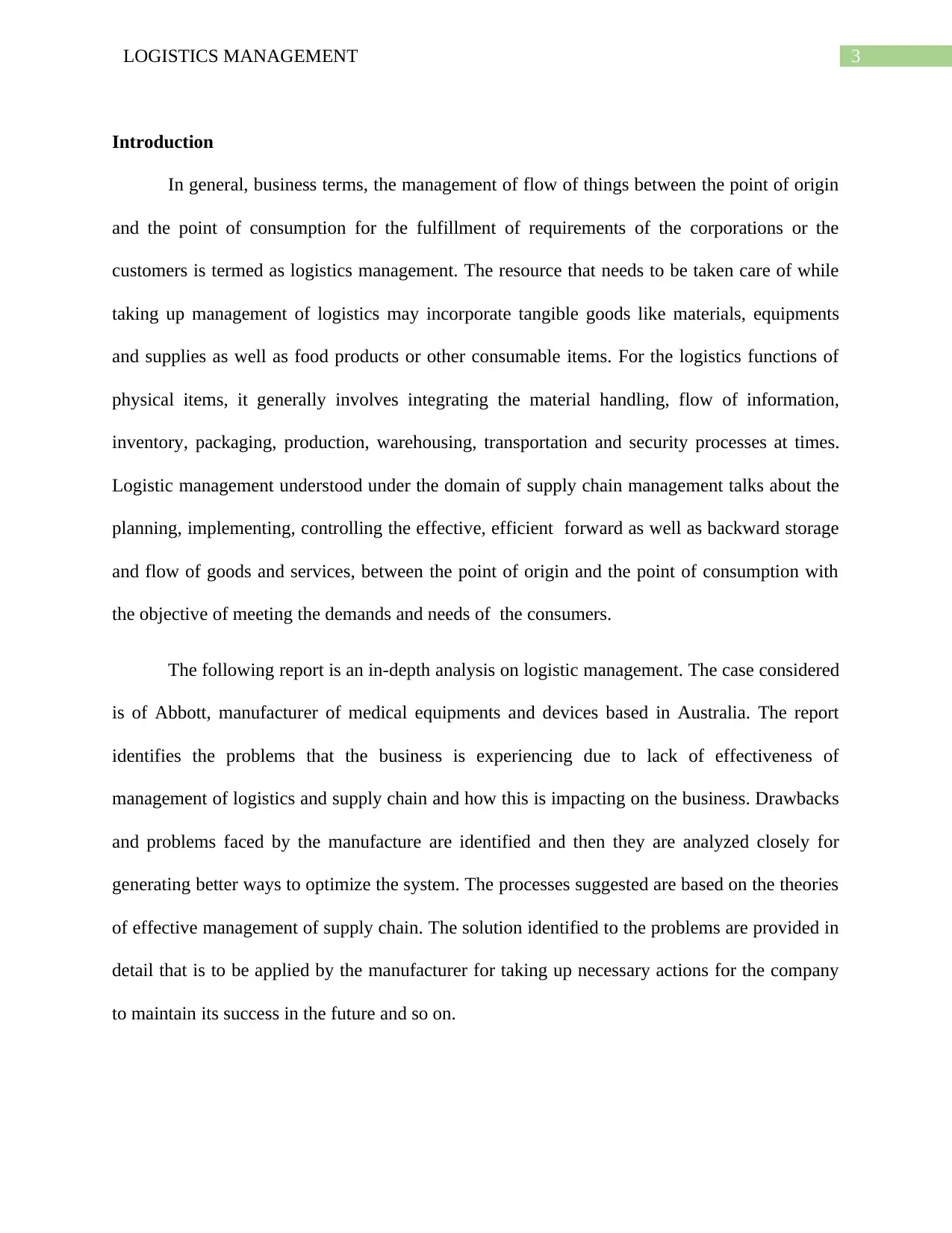
3LOGISTICS MANAGEMENT
Introduction
In general, business terms, the management of flow of things between the point of origin
and the point of consumption for the fulfillment of requirements of the corporations or the
customers is termed as logistics management. The resource that needs to be taken care of while
taking up management of logistics may incorporate tangible goods like materials, equipments
and supplies as well as food products or other consumable items. For the logistics functions of
physical items, it generally involves integrating the material handling, flow of information,
inventory, packaging, production, warehousing, transportation and security processes at times.
Logistic management understood under the domain of supply chain management talks about the
planning, implementing, controlling the effective, efficient forward as well as backward storage
and flow of goods and services, between the point of origin and the point of consumption with
the objective of meeting the demands and needs of the consumers.
The following report is an in-depth analysis on logistic management. The case considered
is of Abbott, manufacturer of medical equipments and devices based in Australia. The report
identifies the problems that the business is experiencing due to lack of effectiveness of
management of logistics and supply chain and how this is impacting on the business. Drawbacks
and problems faced by the manufacture are identified and then they are analyzed closely for
generating better ways to optimize the system. The processes suggested are based on the theories
of effective management of supply chain. The solution identified to the problems are provided in
detail that is to be applied by the manufacturer for taking up necessary actions for the company
to maintain its success in the future and so on.
Introduction
In general, business terms, the management of flow of things between the point of origin
and the point of consumption for the fulfillment of requirements of the corporations or the
customers is termed as logistics management. The resource that needs to be taken care of while
taking up management of logistics may incorporate tangible goods like materials, equipments
and supplies as well as food products or other consumable items. For the logistics functions of
physical items, it generally involves integrating the material handling, flow of information,
inventory, packaging, production, warehousing, transportation and security processes at times.
Logistic management understood under the domain of supply chain management talks about the
planning, implementing, controlling the effective, efficient forward as well as backward storage
and flow of goods and services, between the point of origin and the point of consumption with
the objective of meeting the demands and needs of the consumers.
The following report is an in-depth analysis on logistic management. The case considered
is of Abbott, manufacturer of medical equipments and devices based in Australia. The report
identifies the problems that the business is experiencing due to lack of effectiveness of
management of logistics and supply chain and how this is impacting on the business. Drawbacks
and problems faced by the manufacture are identified and then they are analyzed closely for
generating better ways to optimize the system. The processes suggested are based on the theories
of effective management of supply chain. The solution identified to the problems are provided in
detail that is to be applied by the manufacturer for taking up necessary actions for the company
to maintain its success in the future and so on.
Paraphrase This Document
Need a fresh take? Get an instant paraphrase of this document with our AI Paraphraser
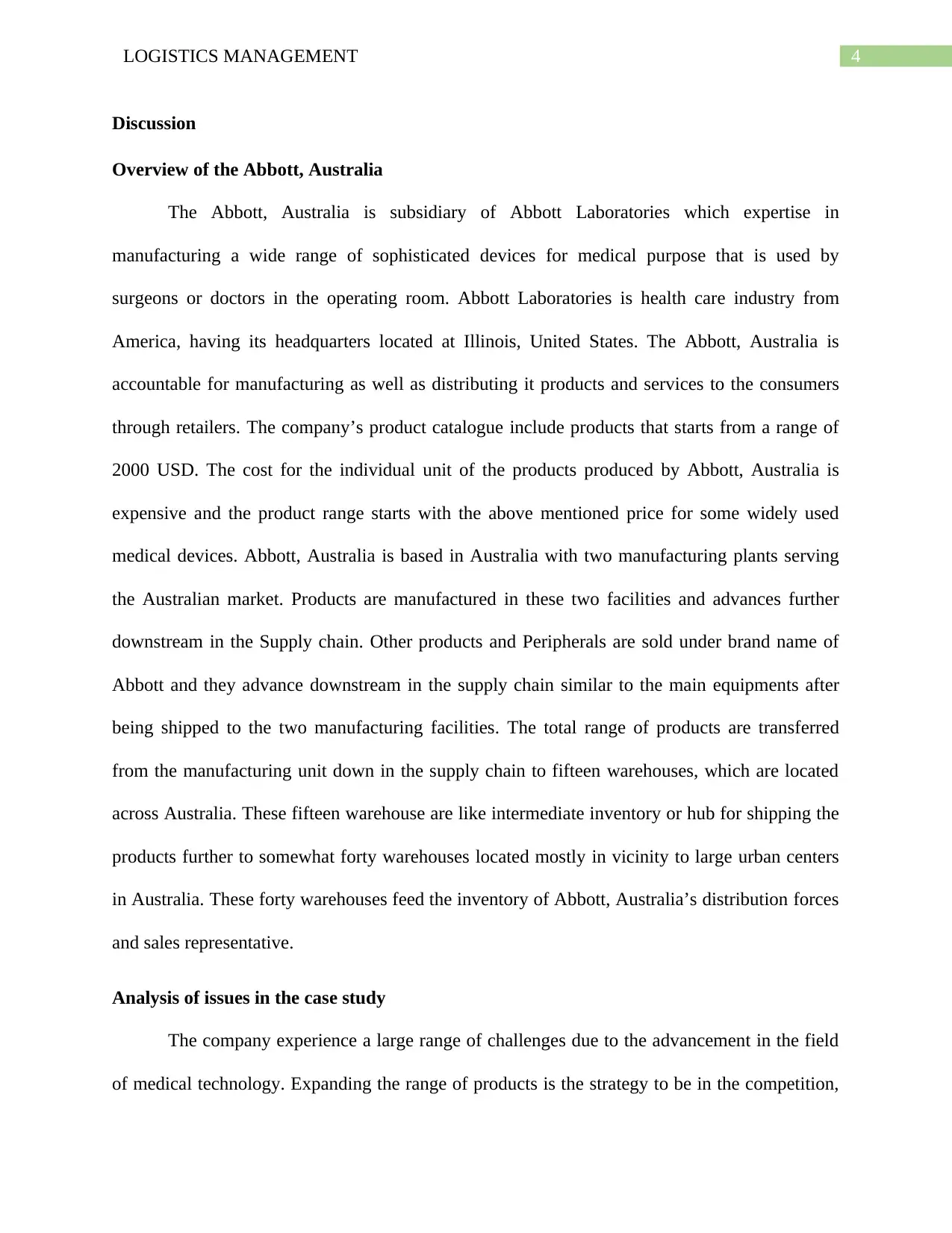
4LOGISTICS MANAGEMENT
Discussion
Overview of the Abbott, Australia
The Abbott, Australia is subsidiary of Abbott Laboratories which expertise in
manufacturing a wide range of sophisticated devices for medical purpose that is used by
surgeons or doctors in the operating room. Abbott Laboratories is health care industry from
America, having its headquarters located at Illinois, United States. The Abbott, Australia is
accountable for manufacturing as well as distributing it products and services to the consumers
through retailers. The company’s product catalogue include products that starts from a range of
2000 USD. The cost for the individual unit of the products produced by Abbott, Australia is
expensive and the product range starts with the above mentioned price for some widely used
medical devices. Abbott, Australia is based in Australia with two manufacturing plants serving
the Australian market. Products are manufactured in these two facilities and advances further
downstream in the Supply chain. Other products and Peripherals are sold under brand name of
Abbott and they advance downstream in the supply chain similar to the main equipments after
being shipped to the two manufacturing facilities. The total range of products are transferred
from the manufacturing unit down in the supply chain to fifteen warehouses, which are located
across Australia. These fifteen warehouse are like intermediate inventory or hub for shipping the
products further to somewhat forty warehouses located mostly in vicinity to large urban centers
in Australia. These forty warehouses feed the inventory of Abbott, Australia’s distribution forces
and sales representative.
Analysis of issues in the case study
The company experience a large range of challenges due to the advancement in the field
of medical technology. Expanding the range of products is the strategy to be in the competition,
Discussion
Overview of the Abbott, Australia
The Abbott, Australia is subsidiary of Abbott Laboratories which expertise in
manufacturing a wide range of sophisticated devices for medical purpose that is used by
surgeons or doctors in the operating room. Abbott Laboratories is health care industry from
America, having its headquarters located at Illinois, United States. The Abbott, Australia is
accountable for manufacturing as well as distributing it products and services to the consumers
through retailers. The company’s product catalogue include products that starts from a range of
2000 USD. The cost for the individual unit of the products produced by Abbott, Australia is
expensive and the product range starts with the above mentioned price for some widely used
medical devices. Abbott, Australia is based in Australia with two manufacturing plants serving
the Australian market. Products are manufactured in these two facilities and advances further
downstream in the Supply chain. Other products and Peripherals are sold under brand name of
Abbott and they advance downstream in the supply chain similar to the main equipments after
being shipped to the two manufacturing facilities. The total range of products are transferred
from the manufacturing unit down in the supply chain to fifteen warehouses, which are located
across Australia. These fifteen warehouse are like intermediate inventory or hub for shipping the
products further to somewhat forty warehouses located mostly in vicinity to large urban centers
in Australia. These forty warehouses feed the inventory of Abbott, Australia’s distribution forces
and sales representative.
Analysis of issues in the case study
The company experience a large range of challenges due to the advancement in the field
of medical technology. Expanding the range of products is the strategy to be in the competition,
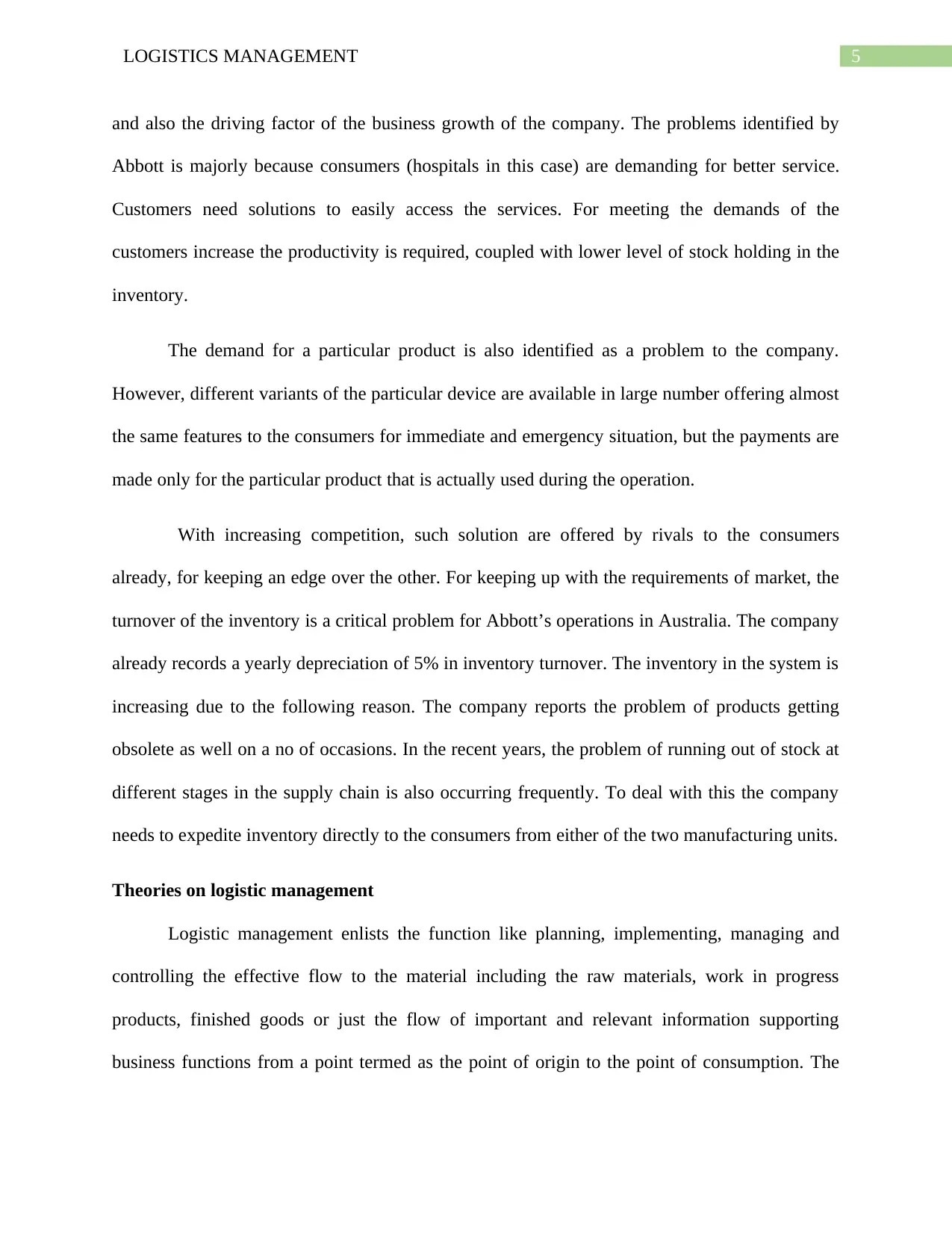
5LOGISTICS MANAGEMENT
and also the driving factor of the business growth of the company. The problems identified by
Abbott is majorly because consumers (hospitals in this case) are demanding for better service.
Customers need solutions to easily access the services. For meeting the demands of the
customers increase the productivity is required, coupled with lower level of stock holding in the
inventory.
The demand for a particular product is also identified as a problem to the company.
However, different variants of the particular device are available in large number offering almost
the same features to the consumers for immediate and emergency situation, but the payments are
made only for the particular product that is actually used during the operation.
With increasing competition, such solution are offered by rivals to the consumers
already, for keeping an edge over the other. For keeping up with the requirements of market, the
turnover of the inventory is a critical problem for Abbott’s operations in Australia. The company
already records a yearly depreciation of 5% in inventory turnover. The inventory in the system is
increasing due to the following reason. The company reports the problem of products getting
obsolete as well on a no of occasions. In the recent years, the problem of running out of stock at
different stages in the supply chain is also occurring frequently. To deal with this the company
needs to expedite inventory directly to the consumers from either of the two manufacturing units.
Theories on logistic management
Logistic management enlists the function like planning, implementing, managing and
controlling the effective flow to the material including the raw materials, work in progress
products, finished goods or just the flow of important and relevant information supporting
business functions from a point termed as the point of origin to the point of consumption. The
and also the driving factor of the business growth of the company. The problems identified by
Abbott is majorly because consumers (hospitals in this case) are demanding for better service.
Customers need solutions to easily access the services. For meeting the demands of the
customers increase the productivity is required, coupled with lower level of stock holding in the
inventory.
The demand for a particular product is also identified as a problem to the company.
However, different variants of the particular device are available in large number offering almost
the same features to the consumers for immediate and emergency situation, but the payments are
made only for the particular product that is actually used during the operation.
With increasing competition, such solution are offered by rivals to the consumers
already, for keeping an edge over the other. For keeping up with the requirements of market, the
turnover of the inventory is a critical problem for Abbott’s operations in Australia. The company
already records a yearly depreciation of 5% in inventory turnover. The inventory in the system is
increasing due to the following reason. The company reports the problem of products getting
obsolete as well on a no of occasions. In the recent years, the problem of running out of stock at
different stages in the supply chain is also occurring frequently. To deal with this the company
needs to expedite inventory directly to the consumers from either of the two manufacturing units.
Theories on logistic management
Logistic management enlists the function like planning, implementing, managing and
controlling the effective flow to the material including the raw materials, work in progress
products, finished goods or just the flow of important and relevant information supporting
business functions from a point termed as the point of origin to the point of consumption. The
⊘ This is a preview!⊘
Do you want full access?
Subscribe today to unlock all pages.

Trusted by 1+ million students worldwide
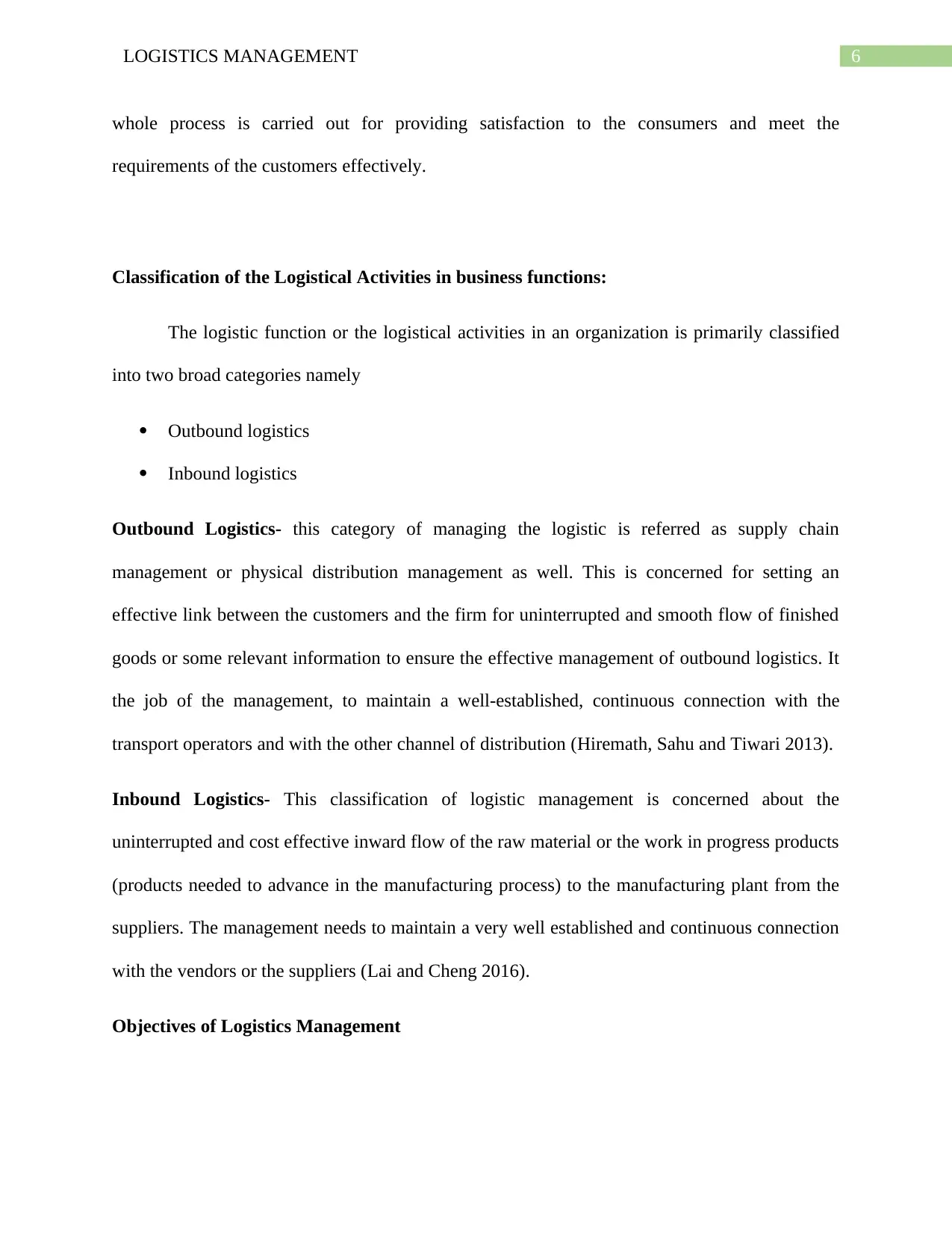
6LOGISTICS MANAGEMENT
whole process is carried out for providing satisfaction to the consumers and meet the
requirements of the customers effectively.
Classification of the Logistical Activities in business functions:
The logistic function or the logistical activities in an organization is primarily classified
into two broad categories namely
Outbound logistics
Inbound logistics
Outbound Logistics- this category of managing the logistic is referred as supply chain
management or physical distribution management as well. This is concerned for setting an
effective link between the customers and the firm for uninterrupted and smooth flow of finished
goods or some relevant information to ensure the effective management of outbound logistics. It
the job of the management, to maintain a well-established, continuous connection with the
transport operators and with the other channel of distribution (Hiremath, Sahu and Tiwari 2013).
Inbound Logistics- This classification of logistic management is concerned about the
uninterrupted and cost effective inward flow of the raw material or the work in progress products
(products needed to advance in the manufacturing process) to the manufacturing plant from the
suppliers. The management needs to maintain a very well established and continuous connection
with the vendors or the suppliers (Lai and Cheng 2016).
Objectives of Logistics Management
whole process is carried out for providing satisfaction to the consumers and meet the
requirements of the customers effectively.
Classification of the Logistical Activities in business functions:
The logistic function or the logistical activities in an organization is primarily classified
into two broad categories namely
Outbound logistics
Inbound logistics
Outbound Logistics- this category of managing the logistic is referred as supply chain
management or physical distribution management as well. This is concerned for setting an
effective link between the customers and the firm for uninterrupted and smooth flow of finished
goods or some relevant information to ensure the effective management of outbound logistics. It
the job of the management, to maintain a well-established, continuous connection with the
transport operators and with the other channel of distribution (Hiremath, Sahu and Tiwari 2013).
Inbound Logistics- This classification of logistic management is concerned about the
uninterrupted and cost effective inward flow of the raw material or the work in progress products
(products needed to advance in the manufacturing process) to the manufacturing plant from the
suppliers. The management needs to maintain a very well established and continuous connection
with the vendors or the suppliers (Lai and Cheng 2016).
Objectives of Logistics Management
Paraphrase This Document
Need a fresh take? Get an instant paraphrase of this document with our AI Paraphraser
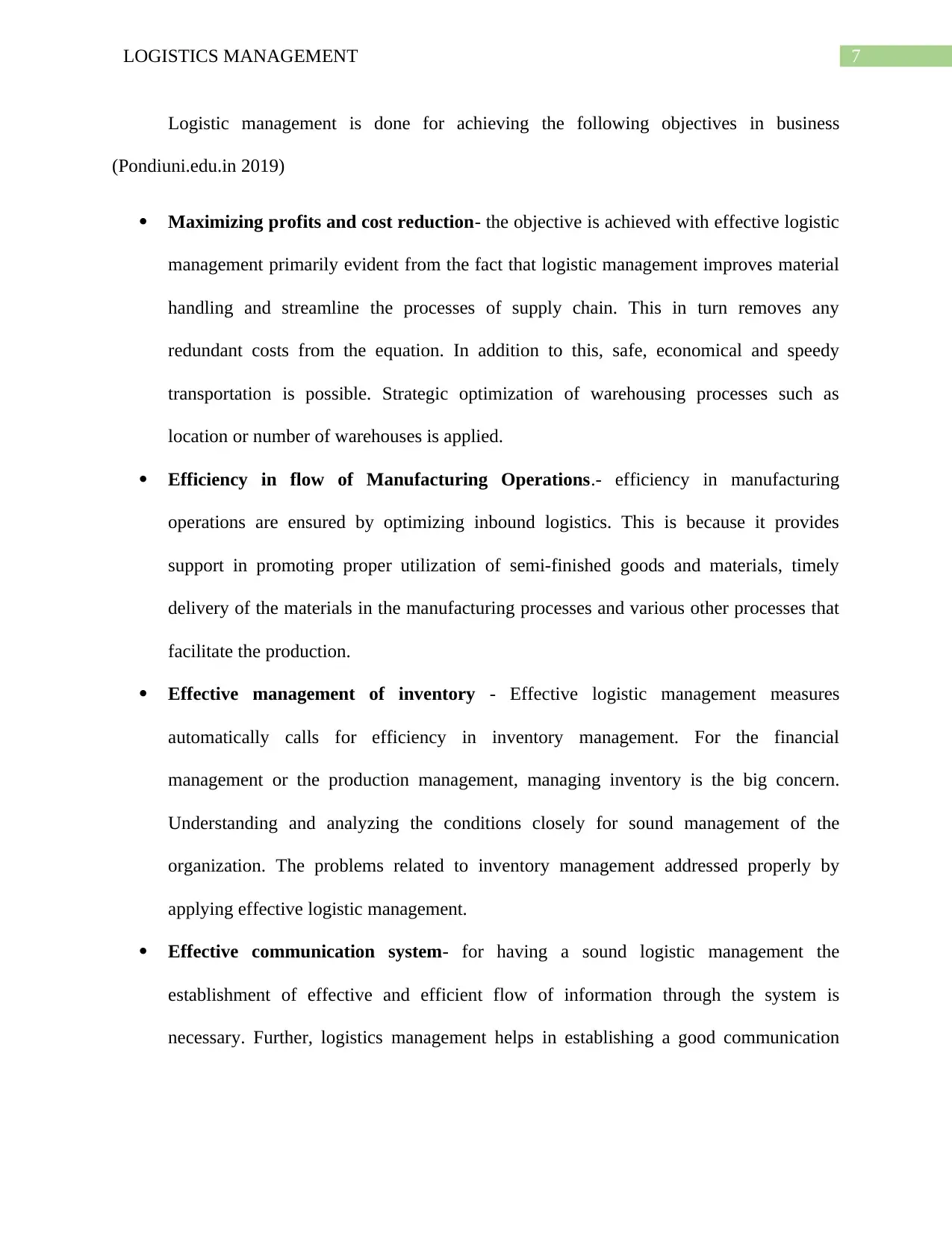
7LOGISTICS MANAGEMENT
Logistic management is done for achieving the following objectives in business
(Pondiuni.edu.in 2019)
Maximizing profits and cost reduction- the objective is achieved with effective logistic
management primarily evident from the fact that logistic management improves material
handling and streamline the processes of supply chain. This in turn removes any
redundant costs from the equation. In addition to this, safe, economical and speedy
transportation is possible. Strategic optimization of warehousing processes such as
location or number of warehouses is applied.
Efficiency in flow of Manufacturing Operations.- efficiency in manufacturing
operations are ensured by optimizing inbound logistics. This is because it provides
support in promoting proper utilization of semi-finished goods and materials, timely
delivery of the materials in the manufacturing processes and various other processes that
facilitate the production.
Effective management of inventory - Effective logistic management measures
automatically calls for efficiency in inventory management. For the financial
management or the production management, managing inventory is the big concern.
Understanding and analyzing the conditions closely for sound management of the
organization. The problems related to inventory management addressed properly by
applying effective logistic management.
Effective communication system- for having a sound logistic management the
establishment of effective and efficient flow of information through the system is
necessary. Further, logistics management helps in establishing a good communication
Logistic management is done for achieving the following objectives in business
(Pondiuni.edu.in 2019)
Maximizing profits and cost reduction- the objective is achieved with effective logistic
management primarily evident from the fact that logistic management improves material
handling and streamline the processes of supply chain. This in turn removes any
redundant costs from the equation. In addition to this, safe, economical and speedy
transportation is possible. Strategic optimization of warehousing processes such as
location or number of warehouses is applied.
Efficiency in flow of Manufacturing Operations.- efficiency in manufacturing
operations are ensured by optimizing inbound logistics. This is because it provides
support in promoting proper utilization of semi-finished goods and materials, timely
delivery of the materials in the manufacturing processes and various other processes that
facilitate the production.
Effective management of inventory - Effective logistic management measures
automatically calls for efficiency in inventory management. For the financial
management or the production management, managing inventory is the big concern.
Understanding and analyzing the conditions closely for sound management of the
organization. The problems related to inventory management addressed properly by
applying effective logistic management.
Effective communication system- for having a sound logistic management the
establishment of effective and efficient flow of information through the system is
necessary. Further, logistics management helps in establishing a good communication
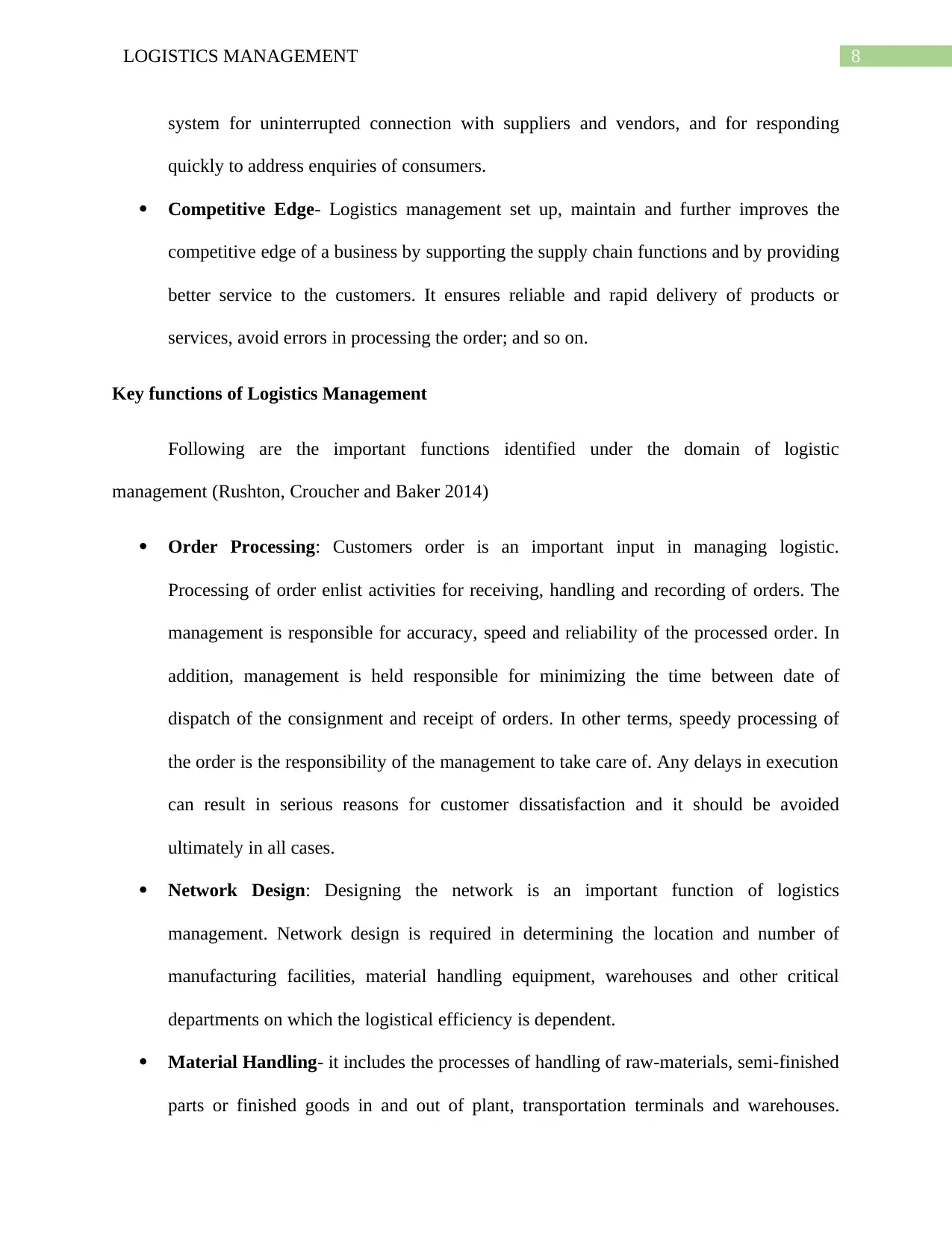
8LOGISTICS MANAGEMENT
system for uninterrupted connection with suppliers and vendors, and for responding
quickly to address enquiries of consumers.
Competitive Edge- Logistics management set up, maintain and further improves the
competitive edge of a business by supporting the supply chain functions and by providing
better service to the customers. It ensures reliable and rapid delivery of products or
services, avoid errors in processing the order; and so on.
Key functions of Logistics Management
Following are the important functions identified under the domain of logistic
management (Rushton, Croucher and Baker 2014)
Order Processing: Customers order is an important input in managing logistic.
Processing of order enlist activities for receiving, handling and recording of orders. The
management is responsible for accuracy, speed and reliability of the processed order. In
addition, management is held responsible for minimizing the time between date of
dispatch of the consignment and receipt of orders. In other terms, speedy processing of
the order is the responsibility of the management to take care of. Any delays in execution
can result in serious reasons for customer dissatisfaction and it should be avoided
ultimately in all cases.
Network Design: Designing the network is an important function of logistics
management. Network design is required in determining the location and number of
manufacturing facilities, material handling equipment, warehouses and other critical
departments on which the logistical efficiency is dependent.
Material Handling- it includes the processes of handling of raw-materials, semi-finished
parts or finished goods in and out of plant, transportation terminals and warehouses.
system for uninterrupted connection with suppliers and vendors, and for responding
quickly to address enquiries of consumers.
Competitive Edge- Logistics management set up, maintain and further improves the
competitive edge of a business by supporting the supply chain functions and by providing
better service to the customers. It ensures reliable and rapid delivery of products or
services, avoid errors in processing the order; and so on.
Key functions of Logistics Management
Following are the important functions identified under the domain of logistic
management (Rushton, Croucher and Baker 2014)
Order Processing: Customers order is an important input in managing logistic.
Processing of order enlist activities for receiving, handling and recording of orders. The
management is responsible for accuracy, speed and reliability of the processed order. In
addition, management is held responsible for minimizing the time between date of
dispatch of the consignment and receipt of orders. In other terms, speedy processing of
the order is the responsibility of the management to take care of. Any delays in execution
can result in serious reasons for customer dissatisfaction and it should be avoided
ultimately in all cases.
Network Design: Designing the network is an important function of logistics
management. Network design is required in determining the location and number of
manufacturing facilities, material handling equipment, warehouses and other critical
departments on which the logistical efficiency is dependent.
Material Handling- it includes the processes of handling of raw-materials, semi-finished
parts or finished goods in and out of plant, transportation terminals and warehouses.
⊘ This is a preview!⊘
Do you want full access?
Subscribe today to unlock all pages.

Trusted by 1+ million students worldwide
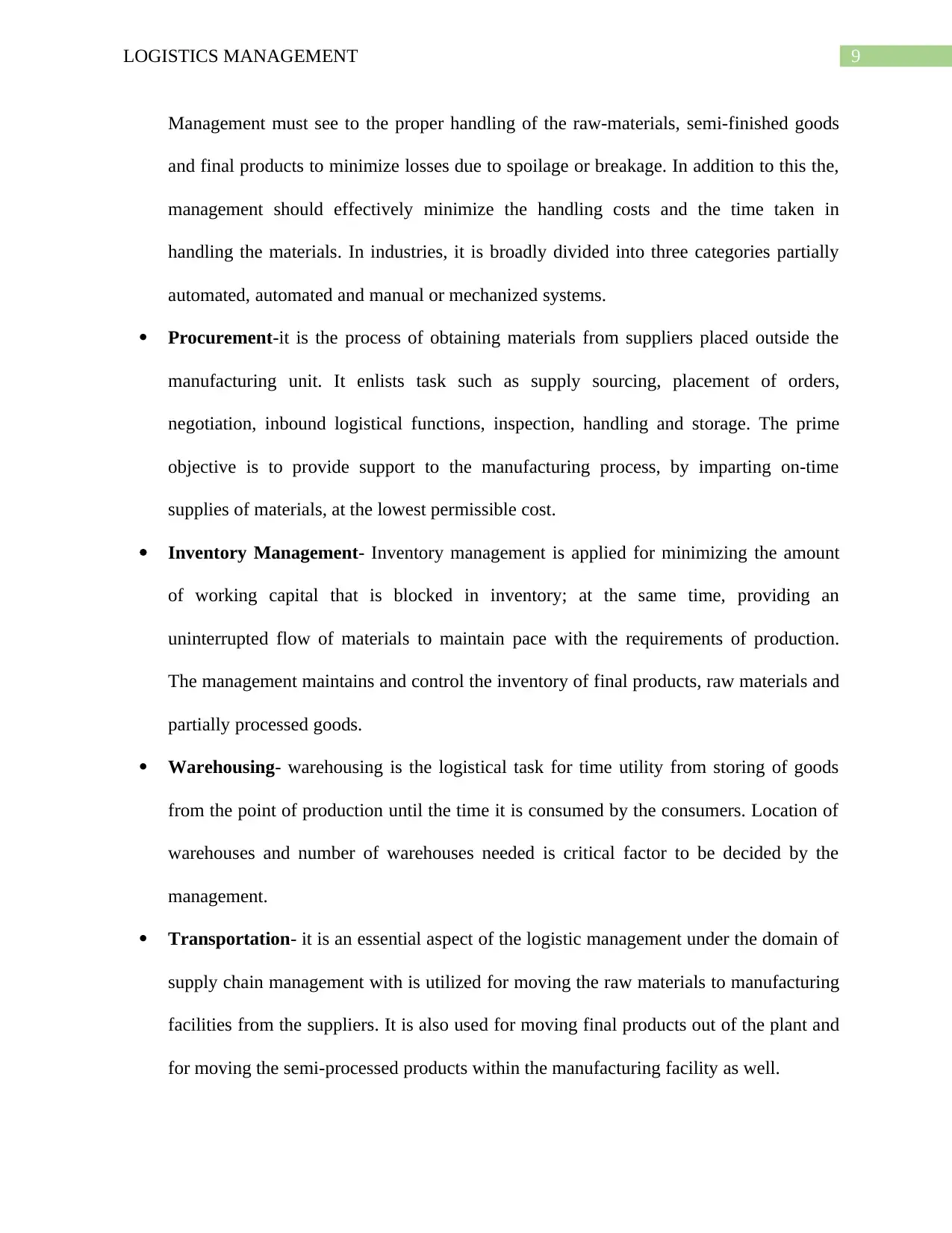
9LOGISTICS MANAGEMENT
Management must see to the proper handling of the raw-materials, semi-finished goods
and final products to minimize losses due to spoilage or breakage. In addition to this the,
management should effectively minimize the handling costs and the time taken in
handling the materials. In industries, it is broadly divided into three categories partially
automated, automated and manual or mechanized systems.
Procurement-it is the process of obtaining materials from suppliers placed outside the
manufacturing unit. It enlists task such as supply sourcing, placement of orders,
negotiation, inbound logistical functions, inspection, handling and storage. The prime
objective is to provide support to the manufacturing process, by imparting on-time
supplies of materials, at the lowest permissible cost.
Inventory Management- Inventory management is applied for minimizing the amount
of working capital that is blocked in inventory; at the same time, providing an
uninterrupted flow of materials to maintain pace with the requirements of production.
The management maintains and control the inventory of final products, raw materials and
partially processed goods.
Warehousing- warehousing is the logistical task for time utility from storing of goods
from the point of production until the time it is consumed by the consumers. Location of
warehouses and number of warehouses needed is critical factor to be decided by the
management.
Transportation- it is an essential aspect of the logistic management under the domain of
supply chain management with is utilized for moving the raw materials to manufacturing
facilities from the suppliers. It is also used for moving final products out of the plant and
for moving the semi-processed products within the manufacturing facility as well.
Management must see to the proper handling of the raw-materials, semi-finished goods
and final products to minimize losses due to spoilage or breakage. In addition to this the,
management should effectively minimize the handling costs and the time taken in
handling the materials. In industries, it is broadly divided into three categories partially
automated, automated and manual or mechanized systems.
Procurement-it is the process of obtaining materials from suppliers placed outside the
manufacturing unit. It enlists task such as supply sourcing, placement of orders,
negotiation, inbound logistical functions, inspection, handling and storage. The prime
objective is to provide support to the manufacturing process, by imparting on-time
supplies of materials, at the lowest permissible cost.
Inventory Management- Inventory management is applied for minimizing the amount
of working capital that is blocked in inventory; at the same time, providing an
uninterrupted flow of materials to maintain pace with the requirements of production.
The management maintains and control the inventory of final products, raw materials and
partially processed goods.
Warehousing- warehousing is the logistical task for time utility from storing of goods
from the point of production until the time it is consumed by the consumers. Location of
warehouses and number of warehouses needed is critical factor to be decided by the
management.
Transportation- it is an essential aspect of the logistic management under the domain of
supply chain management with is utilized for moving the raw materials to manufacturing
facilities from the suppliers. It is also used for moving final products out of the plant and
for moving the semi-processed products within the manufacturing facility as well.
Paraphrase This Document
Need a fresh take? Get an instant paraphrase of this document with our AI Paraphraser
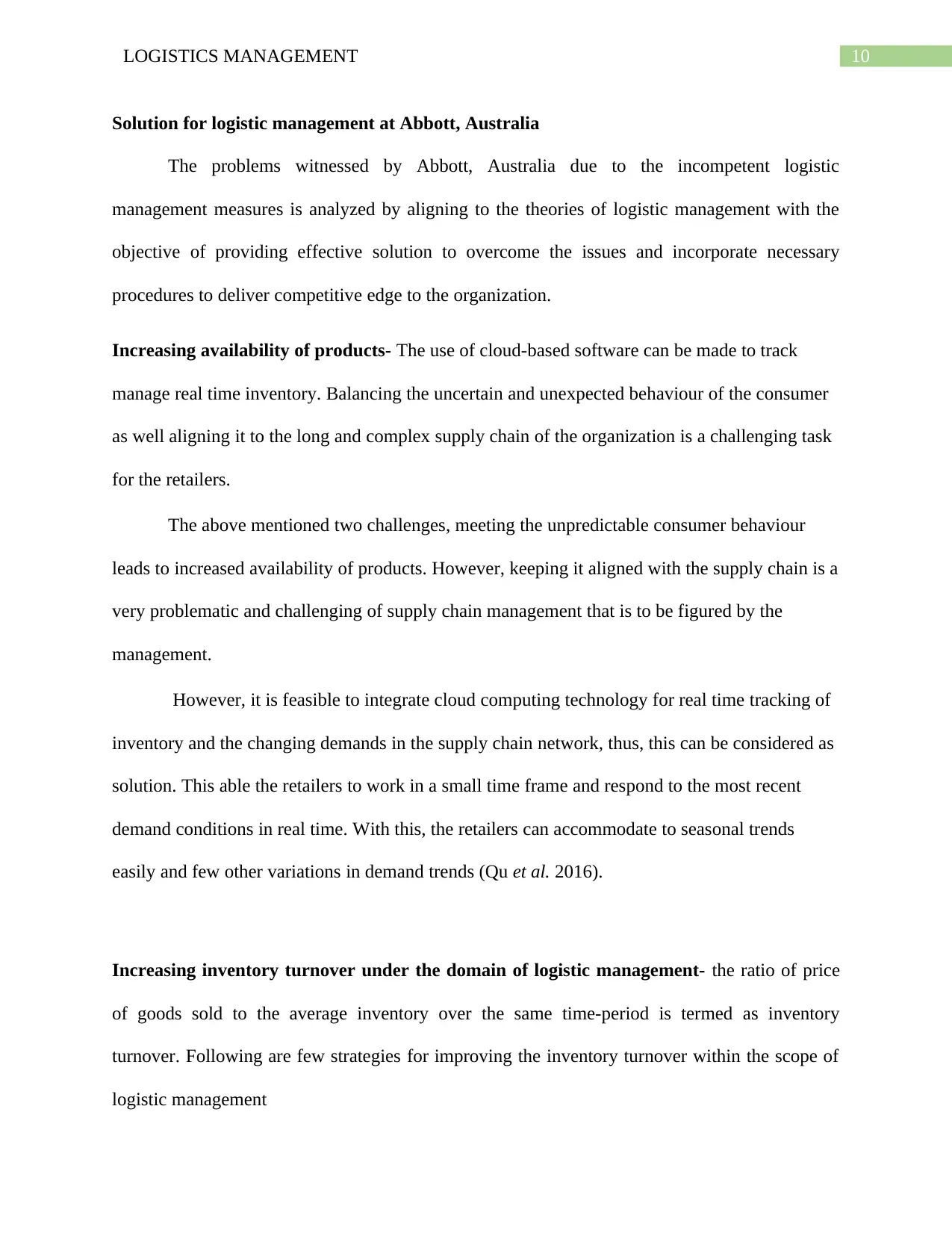
10LOGISTICS MANAGEMENT
Solution for logistic management at Abbott, Australia
The problems witnessed by Abbott, Australia due to the incompetent logistic
management measures is analyzed by aligning to the theories of logistic management with the
objective of providing effective solution to overcome the issues and incorporate necessary
procedures to deliver competitive edge to the organization.
Increasing availability of products- The use of cloud-based software can be made to track
manage real time inventory. Balancing the uncertain and unexpected behaviour of the consumer
as well aligning it to the long and complex supply chain of the organization is a challenging task
for the retailers.
The above mentioned two challenges, meeting the unpredictable consumer behaviour
leads to increased availability of products. However, keeping it aligned with the supply chain is a
very problematic and challenging of supply chain management that is to be figured by the
management.
However, it is feasible to integrate cloud computing technology for real time tracking of
inventory and the changing demands in the supply chain network, thus, this can be considered as
solution. This able the retailers to work in a small time frame and respond to the most recent
demand conditions in real time. With this, the retailers can accommodate to seasonal trends
easily and few other variations in demand trends (Qu et al. 2016).
Increasing inventory turnover under the domain of logistic management- the ratio of price
of goods sold to the average inventory over the same time-period is termed as inventory
turnover. Following are few strategies for improving the inventory turnover within the scope of
logistic management
Solution for logistic management at Abbott, Australia
The problems witnessed by Abbott, Australia due to the incompetent logistic
management measures is analyzed by aligning to the theories of logistic management with the
objective of providing effective solution to overcome the issues and incorporate necessary
procedures to deliver competitive edge to the organization.
Increasing availability of products- The use of cloud-based software can be made to track
manage real time inventory. Balancing the uncertain and unexpected behaviour of the consumer
as well aligning it to the long and complex supply chain of the organization is a challenging task
for the retailers.
The above mentioned two challenges, meeting the unpredictable consumer behaviour
leads to increased availability of products. However, keeping it aligned with the supply chain is a
very problematic and challenging of supply chain management that is to be figured by the
management.
However, it is feasible to integrate cloud computing technology for real time tracking of
inventory and the changing demands in the supply chain network, thus, this can be considered as
solution. This able the retailers to work in a small time frame and respond to the most recent
demand conditions in real time. With this, the retailers can accommodate to seasonal trends
easily and few other variations in demand trends (Qu et al. 2016).
Increasing inventory turnover under the domain of logistic management- the ratio of price
of goods sold to the average inventory over the same time-period is termed as inventory
turnover. Following are few strategies for improving the inventory turnover within the scope of
logistic management
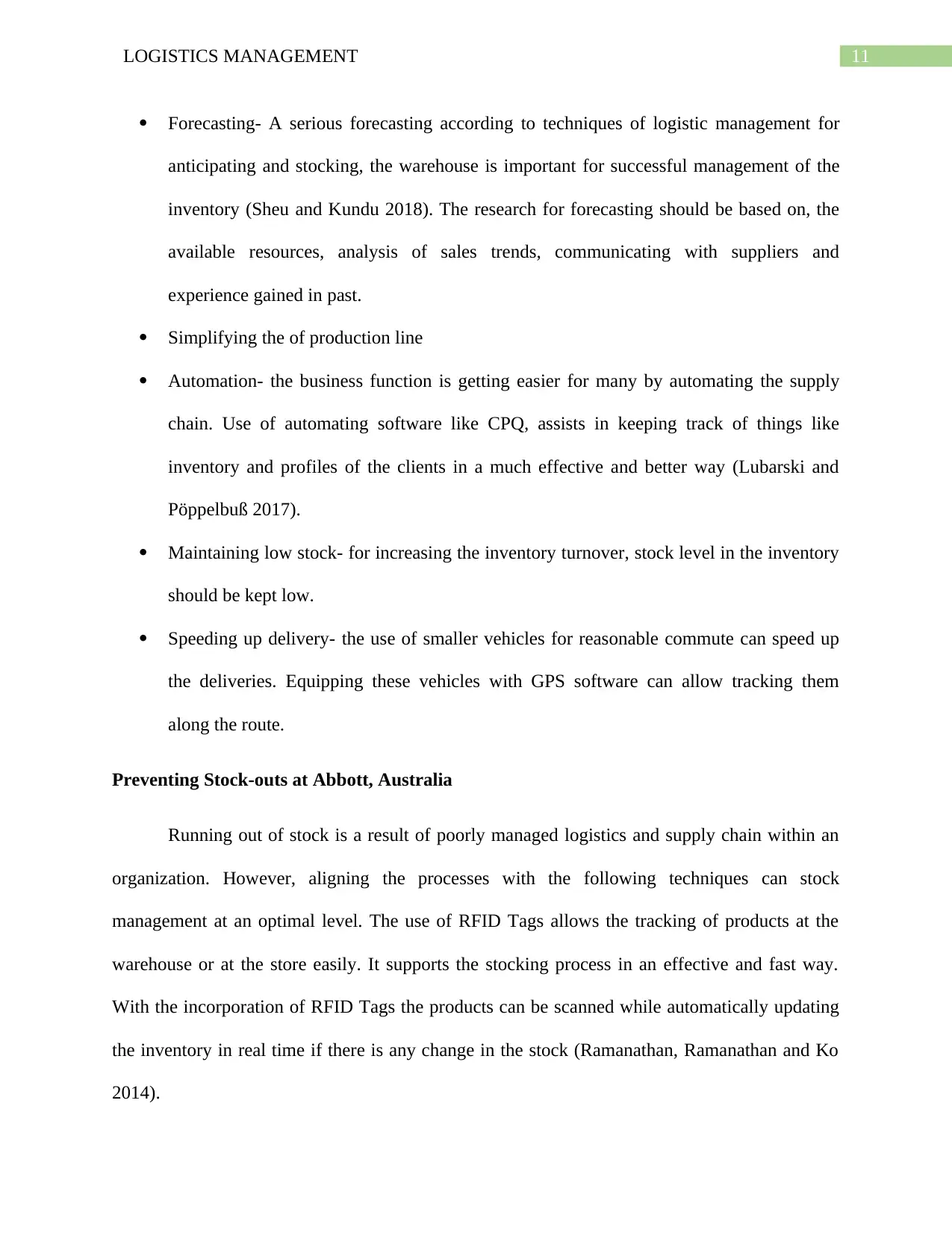
11LOGISTICS MANAGEMENT
Forecasting- A serious forecasting according to techniques of logistic management for
anticipating and stocking, the warehouse is important for successful management of the
inventory (Sheu and Kundu 2018). The research for forecasting should be based on, the
available resources, analysis of sales trends, communicating with suppliers and
experience gained in past.
Simplifying the of production line
Automation- the business function is getting easier for many by automating the supply
chain. Use of automating software like CPQ, assists in keeping track of things like
inventory and profiles of the clients in a much effective and better way (Lubarski and
Pöppelbuß 2017).
Maintaining low stock- for increasing the inventory turnover, stock level in the inventory
should be kept low.
Speeding up delivery- the use of smaller vehicles for reasonable commute can speed up
the deliveries. Equipping these vehicles with GPS software can allow tracking them
along the route.
Preventing Stock-outs at Abbott, Australia
Running out of stock is a result of poorly managed logistics and supply chain within an
organization. However, aligning the processes with the following techniques can stock
management at an optimal level. The use of RFID Tags allows the tracking of products at the
warehouse or at the store easily. It supports the stocking process in an effective and fast way.
With the incorporation of RFID Tags the products can be scanned while automatically updating
the inventory in real time if there is any change in the stock (Ramanathan, Ramanathan and Ko
2014).
Forecasting- A serious forecasting according to techniques of logistic management for
anticipating and stocking, the warehouse is important for successful management of the
inventory (Sheu and Kundu 2018). The research for forecasting should be based on, the
available resources, analysis of sales trends, communicating with suppliers and
experience gained in past.
Simplifying the of production line
Automation- the business function is getting easier for many by automating the supply
chain. Use of automating software like CPQ, assists in keeping track of things like
inventory and profiles of the clients in a much effective and better way (Lubarski and
Pöppelbuß 2017).
Maintaining low stock- for increasing the inventory turnover, stock level in the inventory
should be kept low.
Speeding up delivery- the use of smaller vehicles for reasonable commute can speed up
the deliveries. Equipping these vehicles with GPS software can allow tracking them
along the route.
Preventing Stock-outs at Abbott, Australia
Running out of stock is a result of poorly managed logistics and supply chain within an
organization. However, aligning the processes with the following techniques can stock
management at an optimal level. The use of RFID Tags allows the tracking of products at the
warehouse or at the store easily. It supports the stocking process in an effective and fast way.
With the incorporation of RFID Tags the products can be scanned while automatically updating
the inventory in real time if there is any change in the stock (Ramanathan, Ramanathan and Ko
2014).
⊘ This is a preview!⊘
Do you want full access?
Subscribe today to unlock all pages.

Trusted by 1+ million students worldwide
1 out of 16
Related Documents
Your All-in-One AI-Powered Toolkit for Academic Success.
+13062052269
info@desklib.com
Available 24*7 on WhatsApp / Email
![[object Object]](/_next/static/media/star-bottom.7253800d.svg)
Unlock your academic potential
Copyright © 2020–2025 A2Z Services. All Rights Reserved. Developed and managed by ZUCOL.





